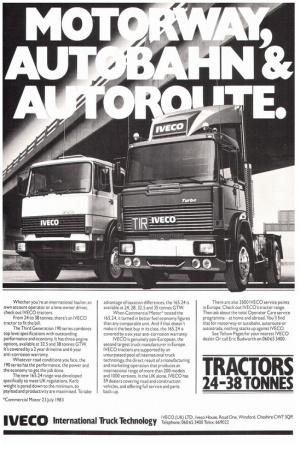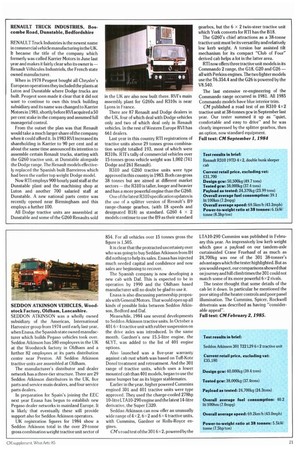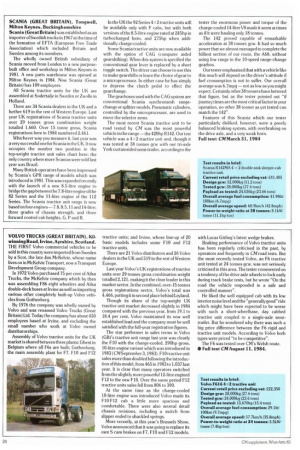Whether you're an international haulier, an own account operator or a lone owner driver, check out IVECO tractors.
Page 108

Page 109

Page 112

If you've noticed an error in this article please click here to report it so we can fix it.
From 24 to 38 tonnes, there's an IVECO tractor to fit the bill.
The Third Generation 190 series combines top level specifications with outstanding performance and economy. It has three engine options, available at 32.5 and 38 tonnes GTW. It's covered by a 2 year driveline and 6 year anti-corrosion warranty.
Whatever road conditions you face, the 190 series has the performance. the power and the economy to get the job done.
The new 165.24 range was developed specifically to meet UK regulations. Kerb weight is pared down to the minimum, so payload and productivity are maximised. To take advantage of taxation differences, the 165.24 is available at 24, 28, 32.5 and 35 tonnes GTVV.
When Commercial Motor* tested the 165.24, it turned in better fuel economy figures than any comparable unit. And if that doesn't make it the best buy in its class, the 165.24 is covered by a six year anti-corrosion warranty.
IVECO is genuinely pan-European, the second largest truck manufacturer in Europe. IVECO tractors are supported by an unsurpassed pool of international truck technology, the direct result of a manufacturing and marketing operation that produces an international range of more than 200 models and 1000 versions. In the UK alone, IVECO has 59 dealers covering road and construction vehicles, and offering full service and parts back-up. There are also 3500 IVECO service points in Europe. Check outIVECO's tractor range. Then ask about the total Operator Care service programme — at home and abroad. You'll find that for motorway or autobahn, autoroute or autostrada, nothing stacks up against IVECO.
See Yellow Pages for your nearest IVECO dealer. Or call Eric Budworth on 060 65 3400.
RENAULT Truck Industries is the newest name in commercial vehicle manufacturing in the UK. It became the title of the company which formerly was called Harrier Motors in June last year and makes it fairly clear who its owner is — Renault Vehicules lndustriels, the French state owned manufacturer.
When in 1978 Peugeot bought all Chrysler's European operations they included the plants at Luton and Dunstable where Dodge trucks are built. Peugeot soon made it clear that it did not want to continue to own this truck building subsidiary and its name was changed to Harrier Motors in 1981, shortly before RVI acquired a 50 per cent stake in the company and assumed full managerial control.
From the outset the plan was that Renault would take a much larger share of the company when it could afford it. In 1983 RVI increased its shareholding in Harrier to 90 per cent and at about the same time announced its intention to assemble certain Renault trucks, starting with the G260 tractive unit, at Dunstable alongside the Dodge range. The Renault models effectively replaced the Spanish built Barreirros which had been the earlier top weight Dodge model.
Now RTI employs 900 hourly paid staff at the Dunstable plant and the machining shop at Luton and another 700 salaried staff at Dunstable. A new national parts centre was recently opened near Birmingham and this employs a further 100.
All Dodge tractive units are assembled at Dunstable and some of the G260 Renaults sold SEDDON ATKINSON VEHICLES, Woodstock Factory, Oldham, Lancashire.
SEDDON ATKINSON was a wholly owned subsidiary of the American, International Harvester group from 1974 until early last year. when Enasa, the Spanish state owned manufacturer which builds Pegaso vehicles took over. Seddon Atkinson has 580 employees in the UK at the Woodstock factory in Oldham and a further 82 employees at its parts distribution centre near Preston. All Seddon Atkinson tractive units are assembled at Oldham.
The manufacturer's distributor and dealer network has a three-tier structure. There are 29 Seddon Atkinson distributors in the UK, five parts and service main dealers, and four service parts dealers.
In preparation for Spain's joining the EEC next year Enasa has begun to establish new Pegaso dealer networks in mainland Europe. It is likely that eventually these will provide support also for Seddon Atkinson operators.
UK registration figures for 1984 show a Seddon Atkinson total in the over 29-tonne gross combination weight tractive unit sector of in the UK are also now built there. RVI's main assembly plant for G260s and R310s is near Lyons in France.
There are 87 Renault and Dodge dealers in the UK. four of which deal with Dodge vehicles only and two of which deal only in Renault vehicles. In the rest of Western Europe RVI has 661 dealers.
Last year in this country RTI registrations of tractive units above 29 tonnes gross combination weight totalled 193, most of which were R310s. RTI's tally of commercial vehicles over 15-tonnes gross vehicle weight was 1,002 (741 Dodge and 261 Renault).
R310 and 6260 tractive units were type approved in this country in 1983. Both can gross 38 tonnes but are aimed at different market sectors —the R310 is taller, longer and heavier and has a more powerful engine than the 6260.
One oft he latest R310 specification updates is the use of a splitter version of Renault's B9 range-change gearbox, (with 18 speeds and designated B18) as standard. G260 4 x 2 models continue to use the B9 as their standard 854. For all vehicles over 15 tonnes gross the figure is 1.505.
It is clear that the protracted uncertainty over who was going to buy Seddan Atkinson from IH did nothing to help its sales. Enasa has injected much needed capital and confidence and now sales are beginning to recover.
The Spanish company is now developing a new cab with Daf. This is expected to be in operation by 1990 and the Oldham based manufacturer will no doubt be glad to use it.
Enasa is also discussing partnership proposals with General Motors. That would open up all kinds of possible links between Seddon Atkinson, Bedford and Daf.
Meanwhile, 1984 saw several developments to Seddon Atkinson tractive units. In October a 401 6 x 4 tractive unit with rubber suspension on the drive axles was introduced. In the same month. Gardner's new 15.5-litre engine, the 6LYT, was added to the list of 401 engine options.
Also launched was a five-year warranty against cab rust which was based on Tuff-Kote Donol treatment and retreatment. And the 301 range of tractive units, which uses a lower mounted cab than 401 models, began to use the same bumper bar as its bigger stablemates.
Earlier in the year. higher powered Cummins engined 301 and 401 tractive units were type approved. They used the charge-cooled 278hp 10-litre LTA10-290 engine and the latest 14-litre derivative, the Super E320.
Seddan Atkinson can now offer an unusually wide range of 4 x2, 6 x 2 and 6 x 4 tractive units, with Cummins, Gardner or Rolls-Royce engines.
CM's road test of the 301 6>< 2, powered by the
gearbox, but the 6 x 2 twin-steer tractive unit which York converts for RTI has the B18.
The 6260's chief attractions as a 38-tonne tractive unit must be its versatility and relatively low kerb weight. A torsion bar assisted tilt mechanism for its compact "Club of Four" derived cab helps a lot in the latter area.
RTI now offers three tractive unit models in its Commando 2 range, the 618, 620 and 626 — all with Perkins engines. The two lighter models use the T6.354.4 and the G26 is powered by the V8.540.
The last extensive re-engineering of the Commando range occurred in 1981. All 1985 Commando models have blue interior trim.
CM published a road test of an R310 4x 2 tractive unit at 38-tonnes gcw in September last year. Our tester summed it up as "quiet, comfortable and easy to drive" and he was clearly impressed by the splitter gearbox, then an option, now standard equipment.
Full test: CM September 1, 1984 LTA10-290 Cummins was published in February this year. An impressively low kerb weight which gave a payload on our tandem-axle curtainsided Crane Fruehauf of as much as 24,700kg was one of the 301 38-tonner's advantages whichthe tester highlighted. But as you would expect, our comparisons showed that on journey and hill climb times the 301 could not match some of its more powerful 6 x 2 rivals.
The tester thought that some details of the cab let it down. In particular he mentioned the poor siting of the heater controls and poor panel Illumination. The Cummins, Spicer, Rockwell drivetrain was described as having "considerable appeal".
Full test: CM February 2, 1985.
SCAN1A (GREAT BRITAIN), Tongwell, Milton Keynes, Buckinghamshire
Scania (Great Britain) was established as an importer of Swedishtrucks in 1967 at the time of the formation of EFTA (European Free Trade Association) which included Britain and Sweden among its members.
The wholly owned British subsidiary of Scania moved from London to a new purposebuilt office and workshop in Milton Keynes in 1981. A new parts warehouse was opened at Milton Keynes in 1984. Now Scania (Great Britain) has 109 employees.
All Scania tractive units for the UK are assembled at Sodertalje in Sweden or Zwolle in Holland.
There are 34 Scania dealers in the UK and a further 619 in the rest of Western Europe. Last year UK registrations of Scania tractive units over 29 tonnes gross combination weight totalled 1.660. Over 15 tonne gross, Scania registrations here in 1984 numbered 2,461.
Whichever way you measure it, last year was a very successful one for Scania in the UK. It now occupies the number two position in the top-weight tractive unit sales chart here; the only country where more Scanias were sold last year was Brazil.
Many British operators have been impressed by Scania's GPR range of models which was introduced in 1981_ This was expanded recently with the launch of a new 8.5-litre engine to bridge the gap between the 7.8-litre engine of the 82 Series and the 11-litre engine of the 112 Series. The Scania tractive unit range is now based on four engines7.8. 8.5. 11 and 14-litre; three grades of chassis strength, and three forward control cab heights. G. P and R.
VOLVO TRUCKS (GREAT BRITAIN), Kilwinning Road, Irvine, Ayrshire, Scotland. THE FIRST Volvo commercial vehicles to be sold in this country were imported from Sweden by a Scot, the late Jim McKelvie, whose name lives on in McKelvie Transport, now a Transport Development Group company.
In 1972 Volvo purchased 75 per cent of Ailsa Trucks, the McKelvie company which by then was assembling F86 eight wheelers and Ailsa double-deck buses at Irvine as well as importing various other completely built-up Volvo vehicles from Gothenburg.
By 1976 the company was wholly owned by Volvo and was renamed Volvo Trucks (Great Britain) Ltd. Today the company has about 450 employees based at Irvine, and excluding the small number who work at Volvo owned distributorships.
Assembly of Volvo tractive units for the UK market is shared between three plants: Ghent in Belgium where all F6s are built; Gothenburg, the main assembly plant for F7. F 10 and F12 In the UK the 92 Series 4 x 2 tractive units will be available only with P cabs, but with both versions of the 8.5-litre engine rated at 245hp in turbocharged form, and 275hp when additionally charge-cooled.
Some Scania tractive units are now available with the option of CAG (computer aided gearshifting). When this system is specified the conventional gear lever is replaced by a short toggle switch. The driver can choose to use this to make gearshifts or leave the choice of gear to a microprocessor. In either case he has simply to depress the clutch pedal to effect the gearchange.
The gearboxes used with the CAG system are conventional Scania synchromesh range. change or splitter models. Pneumatic cylinders, controlled by the microprocessor, are used to move the selector arms.
The most recent Scania tractive unit to be road tested by CM was the most powerful vehicle in the range the 420hp R142. Our test vehicle was a 4 x 2 tractive unit and, though it was tested at 38 tonnes gcw with our tri-axle York curtainsided semi-trailer, according tothe tractive units; and Irvine, whose line-up of 20 basic models includes some F10 and F12 tractive units.
There are 21 Volvo distributors and 26 Volvo dealers in the UK and 519 in the rest of Western Europe.
Last year Volvo's UK registrations of tractive units over 29 tonnes gross combination weight totalled 2,121, making it the clear leader in this market sector. In the combined, over-15 tonnes gross registrations sector, Volvo's total was 4,466, putting it in second place behind Leyland.
Though its share of the top-weight UK tractive unit market decreased slightly in 1984 compared with the previous year. from 19.1 to 18.4 per cent, Volvo maintained its now well established lead and the company must be well satisfied with the full-year registration figures.
The star performer in sales terms in Volvo (GB)'s tractive unit range last year was clearly the F10 with the charge-cooled, 290hp gross, 10-litre engine variant which was introduced in 1983 (CMSeptember 3. 1983). FlOtractive unit sales more than doubled following the introduction of this model, from 465 in 1983 to 1,037 last year. It is clear that many operators switched from the slightly more powerful 12-litre engined F12 to the new F10. Over the same period F12 tractive units sales fell from 806 to 390.
At the same time as the charge-cooled 10-litre engine was introduced Volvo made its F101F12 cab a little more spacious and comfortable. There were also several detail chassis revisions, including a switch from slipper ended to shackled springs.
More recently, at this year's Brussels Show, Volvo announced that it was going to replace its own S cam brakes on F7, F10 and F12 models, tester the enormous power and torque of the charge-cooled 14-litre V8 made it seem at times as if it were hauling only 18 tonnes.
The 142 proved capable of remarkable acceleration at 38 tonnes gcw. It had so much power that we almost managed to complete the hilliest section of our route, the A68. without using low range in the 10-speed range-change gearbox.
Our tester emphasised that with a vehicle like this much will depend on the driver's attitude if fuel consumption is not to suffer. Our overall average was 6.7mpg not as low as you might expect. Certainly other 38 tonners have bettered that figure, but as the tester pointed out "if journey times are the most critical factor in your operation, no other 38 tonner as yet tested can match the 142".
Features of this Scania which our tester particularly disliked, however, were a poorly balanced braking system, with overbraking on the drive axle, and a very weak horn.
Full test: CMMarch 31, 1984 with Lucas Girling's latest wedge brakes.
Braking performance of Volvo tractive units has been regularly criticised in the past, by operators and frequently in CM road tests. But the most recently tested Volvo. an F6 tractive unit tested at 24 tonnes gcw, was not seriously criticised in this area. The tester commented on a tendency of the drive axle wheels to lock early during track brake tests, but he wrote "On the road the vehicle responded in a safe and controlled manner".
He liked the well equipped cab with its low interior noise level and the "generally good" ride which might have been expected to be worse with such a short-wheelbase, day cabbed tractive unit coupled to a single-axle semitrailer. But he wondered why there was such a big price difference between the F6 rigid and tractive unit models. According to Volvo both types were priced "to be competitive".
The F6 was tested over CM's Welsh route.
• Full test CMAugust 11, 1984.
























































































































































